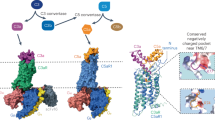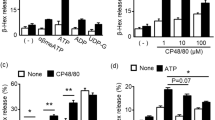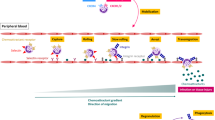Abstract
VARIOUS products of the anaphylactic reaction such as the ECF-A tetrapeptides1 (Val-Gly-Ser-Glu and Ala-Gly-Ser-Glu)2 and histamine3,4 preferentially attract the human eosinophil in chemotaxis in vitro. We have designed experiments to show whether these chemical mediators have a direct effect on the eosinophil cell membrane, as assessed by their capacity to alter receptors for either IgG or complement (C). We have established here that these two ECF-A peptides and histamine both enhance markedly the expression of eosinophil receptors for C3 but not for IgG. Neutrophil and monocyte receptors seemed to be unaltered and a number of other chemical mediators of hypersensitivity had no effect on these membrane markers when tested at comparable concentrations. Our demonstration of eosinophil membrane receptor enhancement by chemotactic factors may have more general biological significance in terms of how surface recognition mechanisms by phagocytic cells are regulated.
This is a preview of subscription content, access via your institution
Access options
Subscribe to this journal
Receive 51 print issues and online access
$199.00 per year
only $3.90 per issue
Buy this article
- Purchase on Springer Link
- Instant access to full article PDF
Prices may be subject to local taxes which are calculated during checkout
Similar content being viewed by others
References
Kay, A. B. & Austen, K. F. J. Immunol. 107, 899–902 (1971).
Goetzl, E. J. & Austen, K. F. Proc. natn. Acad. Sci. U.S.A. 72, 4123–4127 (1975).
Clark, R. A. F., Gallin, J. I. & Kaplan, A. P. J. exp. Med. 142, 1462–1476 (1975).
Turnbull, L. W. & Kay, A. B. Immunology 31, 797–802 (1976).
Day, R. P. Immunology 18, 995–959 (1970).
Böyam, A. Scand. J. clin. Lab. Invest. 21, Suppl. 97, 77–89 (1968).
Lay, W. H. & Nussenzweig, V. J. exp. Med 128, 991–1007 (1968).
Kay, A. B. Br. J. Haemat. 33, 313–318 (1976).
Butterworth, A. E. et al. Nature 256, 727–729 (1975).
Nelson, R. A., Jensen, J., Gigli, I. & Tamura, N. Immunochemistry 3, 111–135 (1965).
Anwar, A. R. E. & Kay, A. B. J. Immunol. (in the press).
Author information
Authors and Affiliations
Rights and permissions
About this article
Cite this article
ANWAR, A., KAY, A. The ECF-A tetrapeptides and histamine selectively enhance human eosinophil complement receptors. Nature 269, 522–524 (1977). https://doi.org/10.1038/269522a0
Received:
Accepted:
Published:
Issue Date:
DOI: https://doi.org/10.1038/269522a0
This article is cited by
-
Eosinophils, mast cells, nerves and ganglion cells in appendicitis
Indian Journal of Surgery (2008)
-
Mechanisms of eosinophil accumulation around eggs ofSchistosoma japonicum: Role of two purified components, allergen and eosinophil chemotactic factor, from soluble egg antigens measured on sensitized guinea pig skin
Parasitology Research (1990)
-
A comparative study on eosinophil and neutrophil chemotactic activities of various helminth parasites
Parasitology Research (1988)
-
Human eosinophil heterogeneity
La Ricerca in Clinica e in Laboratorio (1986)
-
Effects of histamine agonists and antagonists on luminol-dependent chemiluminescence of granulocytes
Agents and Actions (1984)
Comments
By submitting a comment you agree to abide by our Terms and Community Guidelines. If you find something abusive or that does not comply with our terms or guidelines please flag it as inappropriate.



